Breakover Styles
Before:
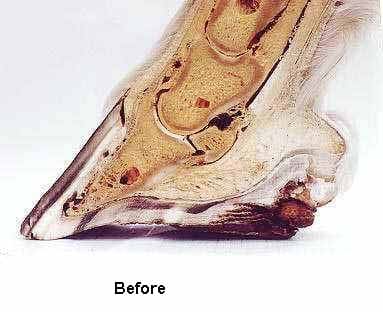
You can back up breakover with a mustang roll and a slight rocker on the bottom--this is backed up further than the examples that follow. This approach allows to have breakover the furthest back, but it will also need to be trimmed more often to maintain this breakover point this far back:
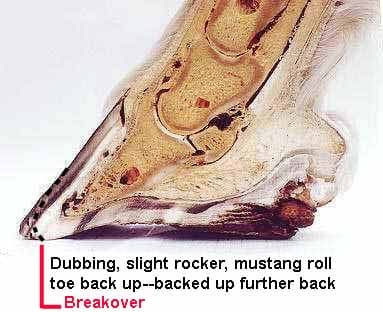
I count as where the breakover starts as where the the ground plane ends at the toe--even if it is just a little rounding. Nonetheless, this is where breakover begins. If breakover depends on this little area of rounded-under curve for keeping breakover back, this will need to be refreshed with a rasp somewhat more often than other styles of backing up breakover. The plusses for this style of breakover is that it can be further back, while still leaving enough toe wall thickness to protect the front of the coffin bone from hitting things when the foot is swinging forward.
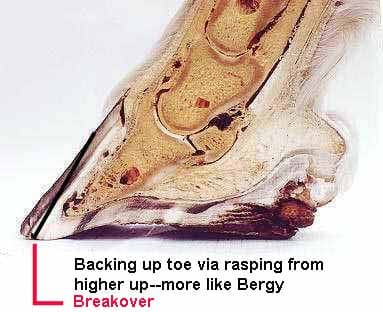
The backing up above will last longer between trims. Many trimmers feel that trimming the toe profile in a straight profile 'trains' the tubules to grow in tighter and straighter in the toe over time.
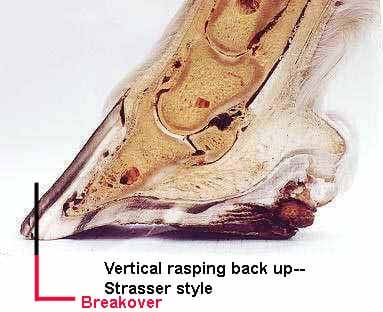
This style of backup lasts a shorter period of time between trims, but protects the front of the coffin bone better than the Bergy style backup.
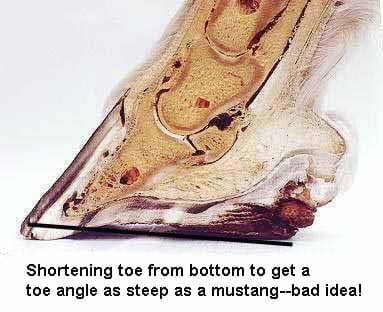
Needless to say, this method of shortening toes is bad news. However, lots of farriers are making this mistake...this is what they are trained to do when they are using nippers to get a target toe length spec as the first step of a trim.
Bergy Basal Formula Backup
The first drawing is the Bergy backup; the 2nd is a rockered toe/mustang roll where breakover starts at the same place, but with a little more thickness higher up to protect the front of the coffin bone from banging into things. I personally feel a little better about the latter style for barefoot hooves. This latter style would need more frequent maintenance to keep it backed up to the same place, though. The first drawing might work OK for a shod horse, but you'd have a little more left to protect the front of the coffin bone from stubbing toes on rocking while swinging forward, etc., in the bottom drawing.
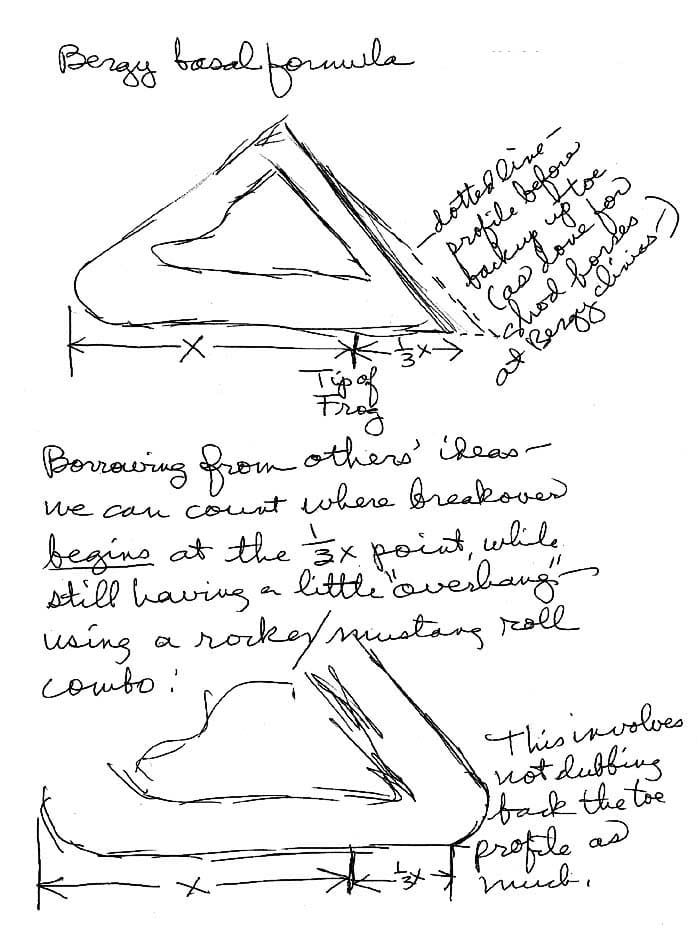
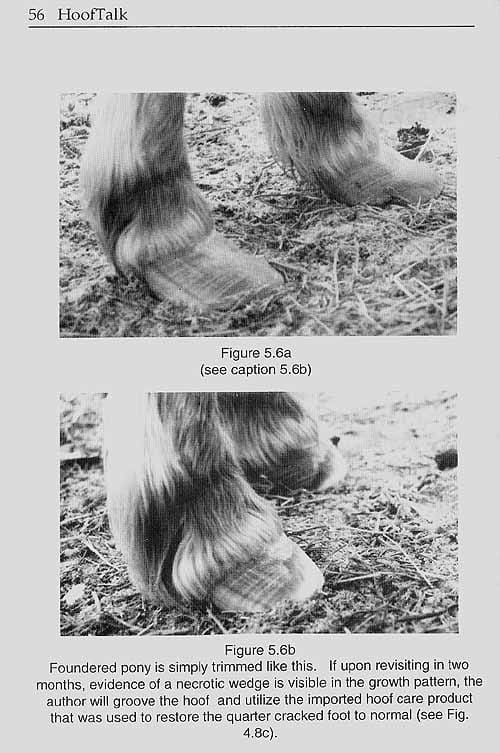
A Bergy trim for a foundered pony.
Bergy gauge does the math for you for finding the breakover:
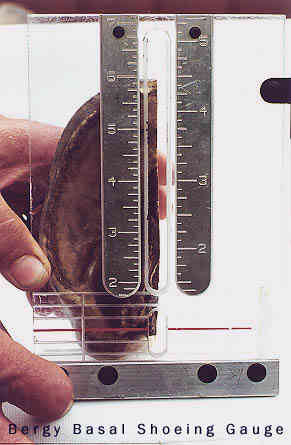
The scale on the left measures from the heel bulb plumb line to the frog apex. The stretched out scale on the right shows where the breakover is. On this hoof, the apex is at 4-1/4". When you go to 4-1/4" on the right hand scale, it marks where the breakover will be. In this case it is in the white line.
BOGHS Trim
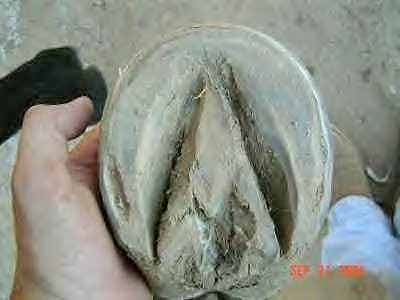
This is a lot more radical version of the Martha Olivo trim. Not much toe wall is hitting ground--it is backed up to the white line almost all the way around. The "moonsickle" or callous area is even wider on the sides than in the front. Breakover is backed up a lot more. Bars are high and fairly far forward. Dirt being packed into the deep crevices next to the frog is welcome as a source of more 'support.' This will lock up (or "support"?) a foot as effectively as heartbar shoeing, or shoeing with full pads and dental impression material, to my view.
Martha Olivo
The Martha Olivo trim backs up breakover to the 1/3--2/3 standard. The distance to from the apex of the frog to the rearmost bearing surface of the heels is 2/3. Half of this, or 1/3, is the distance from the apex of the frog to breakover. This breakover is not as far back as the BOGHS breakover point. Further, if the walls are 1/4" wide in the quarters, the toe wall is backed up until it is also 1/4" thick. (in other words, when viewing the sole, the wall thickness looks the same all the way around the hoof, instead of being thicker-looking in the toe. There is some wall hitting ground all the way around. Here she has 'mapped' a foot, which uses a grid dividing the hoof length and width into 1/6ths...and I drew in with a heavier line various features, and where their location is in relationship to the grid. This was what she was teaching in the summer of 2004, anyway. I understand that she has added more features to this 'sacred geometry' since then.
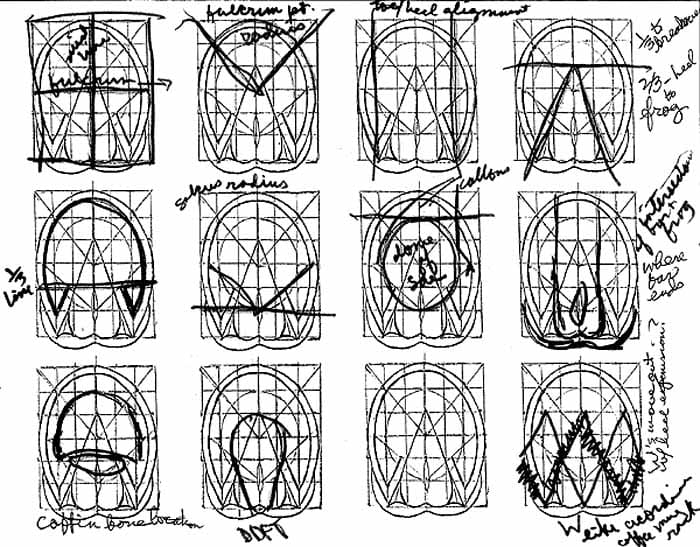
One thing to keep in mind re the apparent thickness of wall being more in the toes and heels than in the quarters:
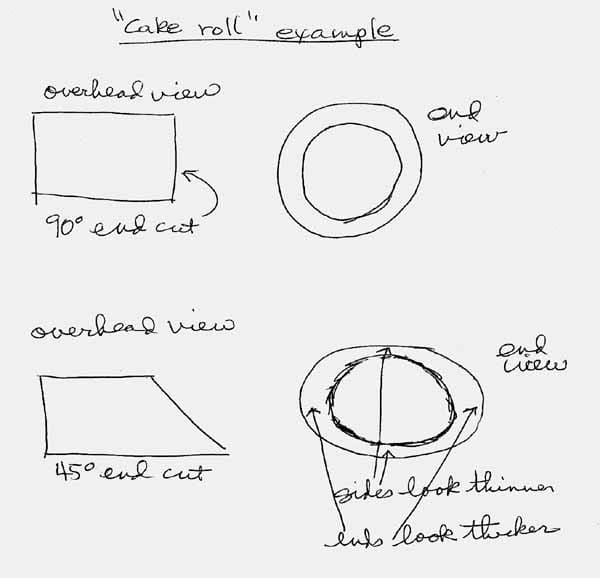
If you were to dissect a cadaver hoof, and pull the wall off in one piece, measurements of its thickness with calipers might not be so much thicker in the toe than the quarters. The place to get the most accurate measurements would be higher up on the wall, where there would be less removed in spots from rasping or dubbing in the past. Thinning the toe wall will have a bit of a hinge effect that can make heel expansion easier. The Bergy backup style would thin the toe wall more than the Martha Olivo trim would, but both would make this area a little more flexible as you get closer to the hoof's ground plane.
Actually, any style of backing up the toe will contribute to this hinge effect, which facilitates heel expansion to varying degrees. Long, slippered toes, on the other hand, encourage heel contraction.
It is not always reliable to back up breakover using the water line, or the white line, as your main landmark. In some very pathological feet, the sole stretches forward. In the Strasser "Big Blue" textbook, here is Rachael Coggin's Boogie, a severe founder case, where it was necessary to back up breakover well into the sole. It is always better to use x-rays to see just how far back you need to put breakover, but a familiarity with proportions of the internal structure of the hoof based on many dissections can also give you an idea of what is going to be needed. This case is on page VI-102:
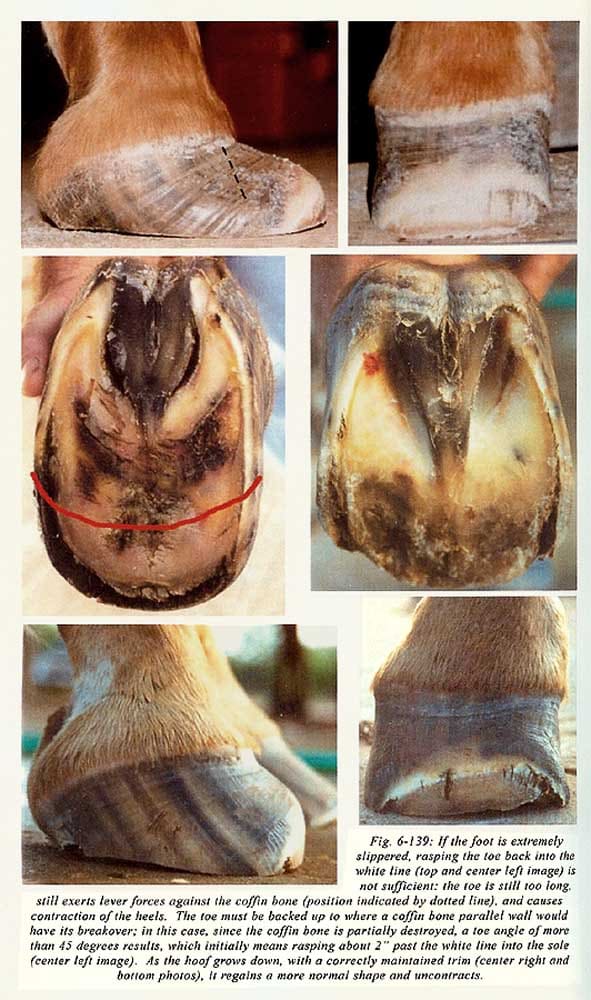
Back to home page--Table of Contents
Article in sections with "thumbnail" photos for fastest downloads:
1 9 17
2 10 18
3 11 19
4 12 20
5 13 21
6 14 22
7 15 23
8 16 24
NAVICULAR
Article in sections with full-sized photos for print-outs:
1 9 17
2 10 18
3 11 19
4 12 20
5 13 21
6 14 22
7 15 23
8 16 24
NAVICULAR
To Strasser case studies--thumbnail photos for faster downloads
To Strasser case studies--large photos
Please sign my guest book! Photos of my pets My farm
Share Barefoot success stories on this page
Buy or sell used HORSE BOOTS Natural board Barn Listings
Click here to subscribe to naturalhorsetrim
(I moderate this listserv to weed out "fluff.")
Copyright by Gretchen Fathauer, 2015. All rights reserved.











